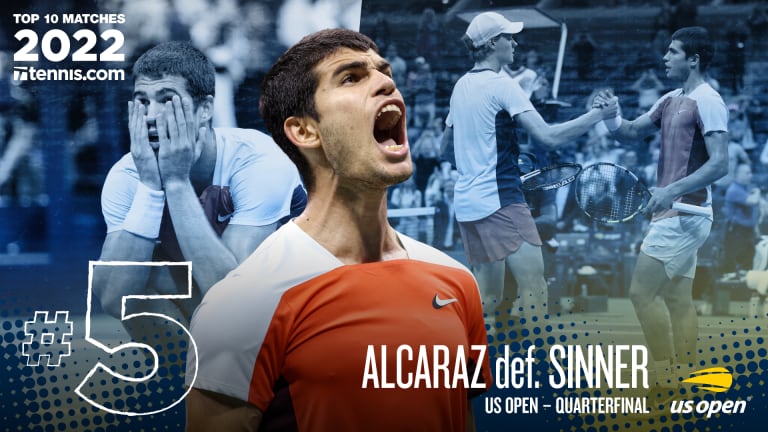The Top 10 Matches of 2022
No. 5 of '22: Carlos Alcaraz and Jannik Sinner beam the future of tennis backwards in time (and play until 2:50 a.m.)
By Dec 05, 2022The Top 10 Matches of 2022
No. 1 of '22: Carlos Alcaraz conquers Novak Djokovic in a classic, kicking off a generations-spanning rivalry
By Dec 09, 2022The Top 10 Matches of 2022
No. 2 of '22: Rafael Nadal never gives up in career-defining Australian Open final reversal against Medvedev
By Dec 08, 2022The Top 10 Matches of 2022
No. 3 of '22: Serena Williams' unforgettable three-night run peaks with a win over the US Open's No. 2 seed
By Dec 07, 2022The Top 10 Matches of 2022
No. 4 of '22: Roger Federer didn't win his farewell match, but a sendoff for the ages eclipsed the final scoreboard
By Dec 06, 2022The Top 10 Matches of 2022
No. 6 of '22: Iga Swiatek was the best this season—and she brought out the best in Barbora Krejcikova
By Dec 02, 2022The Top 10 Matches of 2022
No. 7 of '22: Rafael Nadal, Felix Auger-Aliassime, and tennis of the highest and most engrossing order
By Dec 01, 2022The Top 10 Matches of 2022
No. 8 of '22: Nick Kyrgios and Frances Tiafoe put it all together this season, and in this match
By Nov 30, 2022The Top 10 Matches of 2022
No. 9 of '22: Petra Kvitova edges Garbine Muguruza in US Open third-rounder that felt like a final
By Nov 29, 2022The Top 10 Matches of 2022
No. 10 of '22: 19-year-old Holger Rune arrives with win over Novak Djokovic in Paris Masters final
By Nov 28, 2022No. 5 of '22: Carlos Alcaraz and Jannik Sinner beam the future of tennis backwards in time (and play until 2:50 a.m.)
It felt like the Spaniard and the Italian were raising the ceiling on what was physically possible on a tennis court. This was tennis in overdrive.
Published Dec 05, 2022
Advertising
Advertising
Advertising

Alcaraz and Sinner hit 124 winners between them, came to net 100 times, and generated 42 break points.